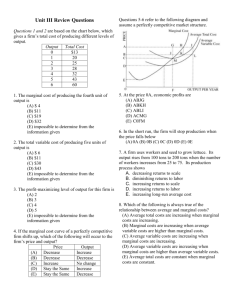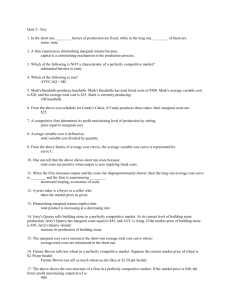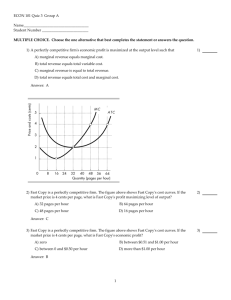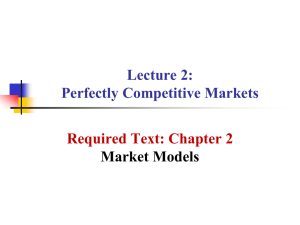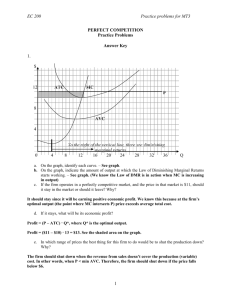Practice Problems Ch. 12 Perfect Competition
advertisement
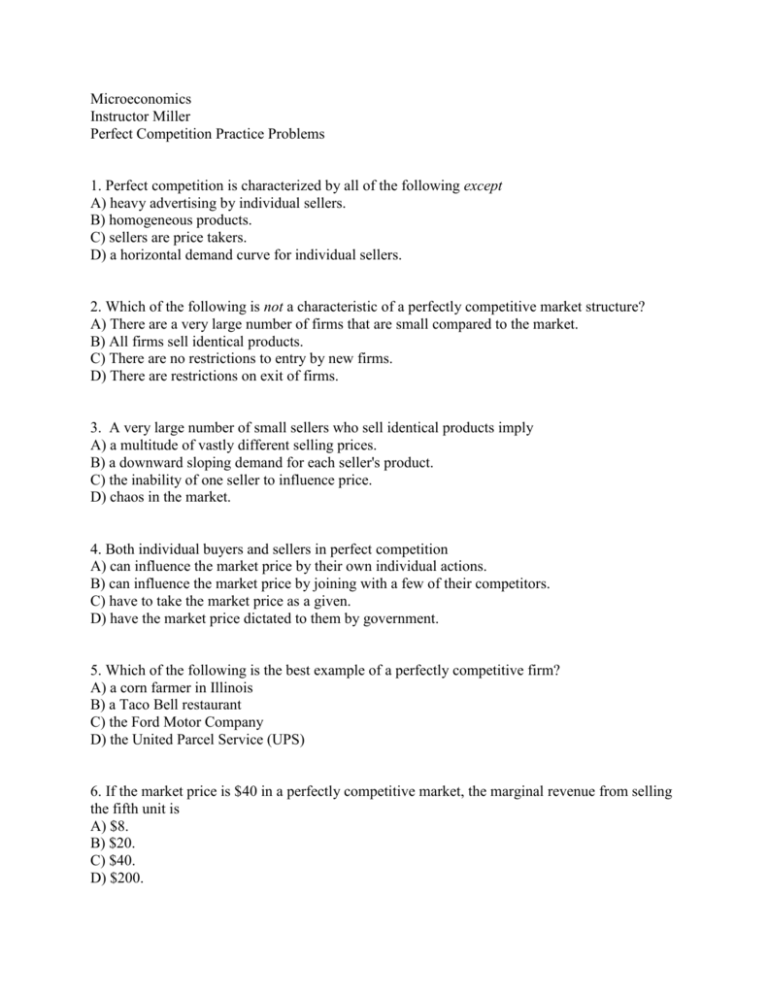
Microeconomics Instructor Miller Perfect Competition Practice Problems 1. Perfect competition is characterized by all of the following except A) heavy advertising by individual sellers. B) homogeneous products. C) sellers are price takers. D) a horizontal demand curve for individual sellers. 2. Which of the following is not a characteristic of a perfectly competitive market structure? A) There are a very large number of firms that are small compared to the market. B) All firms sell identical products. C) There are no restrictions to entry by new firms. D) There are restrictions on exit of firms. 3. A very large number of small sellers who sell identical products imply A) a multitude of vastly different selling prices. B) a downward sloping demand for each seller's product. C) the inability of one seller to influence price. D) chaos in the market. 4. Both individual buyers and sellers in perfect competition A) can influence the market price by their own individual actions. B) can influence the market price by joining with a few of their competitors. C) have to take the market price as a given. D) have the market price dictated to them by government. 5. Which of the following is the best example of a perfectly competitive firm? A) a corn farmer in Illinois B) a Taco Bell restaurant C) the Ford Motor Company D) the United Parcel Service (UPS) 6. If the market price is $40 in a perfectly competitive market, the marginal revenue from selling the fifth unit is A) $8. B) $20. C) $40. D) $200. 7. For a firm in a perfectly competitive market, price is A) equal to both average revenue and marginal revenue. B) equal to average revenue but greater than marginal revenue. C) greater than marginal revenue but less than average revenue. D) less than both average revenue and marginal revenue. 8. Marginal revenue is A) total revenue divided by the total quantity of output. B) the change in profit divided by the change in the quantity of output. C) the change in total revenue divided by the change in total cost. D) the change in total revenue divided by the change in the quantity of output. 9. The marginal revenue curve for a perfectly competitive firm A) is downward-sloping. B) is the same as its demand curve. C) is perfectly inelastic. D) is the same as its marginal cost curve. 10. A perfectly competitive firm's marginal revenue A) is greater than price. B) is less than price because a firm must lower its price to sell more. C) is equal to price. D) may be either greater or less than price, depending on the quantity sold. 11. Producing where marginal revenue equals marginal cost is equivalent to producing where A) average total cost equals average revenue. B) average fixed cost is minimized. C) total revenue is equal to total cost. D) total profit is maximized. 12. At the profit-maximizing level of output for a perfectly competitive firm, price equals marginal cost. Which of the following is also true? A) The difference between total revenue and total cost is the greatest. B) Total revenue equals total cost. C) Average revenue equals average total cost. D) Marginal profit equals marginal cost. 13. If, for the last bushel of apples produced and sold by an apple farm marginal revenue exceeds marginal cost, then in producing that bushel the farm A) added more to total cost than it added to total revenue. B) added an equal amount to both total revenue and total cost. C) added more to total revenue than it added to total cost. D) maximized its profits or minimized its losses. 14. Letters are used to represent the terms used to answer this question: price (P), quantity of output (Q), total cost (TC) and average total cost (ATC). Which of the following equations is equal to a firm's profit? A) P - ATC B) (P × Q) - TC C) (P × Q) - (P × ATC) D) P - TC 15. If a firm shuts down in the short run it will A) break even. B) declare bankruptcy. C) suffer a loss equal to its variable costs. D) suffer a loss equal to its fixed costs. 16. If, for a given output level, a perfectly competitive firm's price is less than its average variable cost, the firm A) is earning a profit. B) should shut down. C) should increase output. D) should increase price. 17. Which of the following is not an option for a perfectly competitive firm that suffers short-run losses? A) shutting down B) reducing production C) reducing the use of variable factors D) raising price . 18. Refer to the above figure. The firm's short-run supply curve is its A) marginal cost curve. B) marginal cost curve from b and above. C) marginal cost curve from c and above. D) marginal cost curve from d and above. 19. Refer to the above figure. Total revenue at the profit-maximizing level of output is A) $1,200. B) $2,500. C) $4,800. D) $6,000. 20. Refer to the above figure. The total cost at the profit-maximizing output level equals A) $4,800. B) $3,300. C) $2,500. D) $1,800. 21. Refer to the above figure. At the profit-maximizing output level, the firm earns A) zero economic profit. B) a profit of $600. C) a profit of $1,200. D) a profit of $2,700. 22. In a perfectly competitive industry, in the long-run equilibrium A) the typical firm is producing at the output where its long-run average total cost is not minimized. B) the typical firm is earning an accounting profit greater than its implicit costs. C) the typical firm earns zero economic profit. D) the typical firm is maximizing its revenue. 23. Fill in the columns in the following table and use the values in the table to determine the profit-maximizing level of output. Total Revenue Quantity (TR) 0 0 1 5 2 10 3 15 4 20 5 25 6 30 7 35 8 40 9 45 10 50 Total Cost (TC) 3 5 6 8 11 15 21 30 42 60 85 Profit Marginal Revenue Marginal (MR) Cost (MC) Key 1. A 2. D 3. C 4. C 5. A 6. C 7. A 8. D 9. B 10. C 11. D 12. A 13. C 14. B 15. D 16. B 17. D 18. B Total Total Marginal Revenue Cost Revenue Marginal Quantity (TR) (TC) Profit (MR) Cost (MC) 0 0 3 -3 ----1 5 5 0 5 2 2 10 6 4 5 1 3 15 8 7 5 2 4 20 11 9 5 3 5 25 15 10 5 4 6 30 21 9 5 6 7 35 30 5 5 9 8 40 42 -2 5 12 9 45 60 -15 5 18 10 50 85 -35 5 25 The profit-maximizing level of output is 5 units. 19. D 20. B 21. D 22. C

